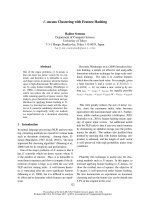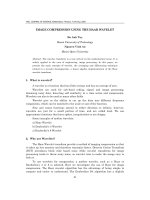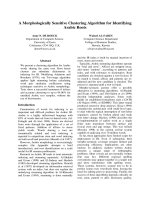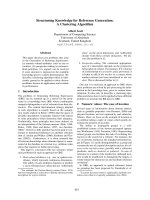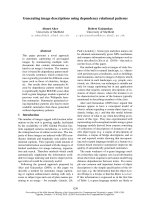Image compression using k mean clustering algorithm
Bạn đang xem bản rút gọn của tài liệu. Xem và tải ngay bản đầy đủ của tài liệu tại đây (514.11 KB, 6 trang )
IJCSNS International Journal of Computer Science and Network Security, VOL.21 No.9, September 2021
275
Image compression using K-mean clustering algorithm
Amani Munshi , Asma Alshehri , Bayan Alharbi, Eman AlGhamdi, Esraa Banajjar, Meznah Albogami, Hanan S.
Alshanbari
Department of Computer Science and Information System, Umm Al-Qura University, Makkah, Saudi Arabia
, , ,
Abstract
With the development of communication networks, the processes
of exchanging and transmitting information rapidly developed. As
millions of images are sent via social media every day, also
wireless sensor networks are now used in all applications to capture
images such as those used in traffic lights, roads and malls.
Therefore, there is a need to reduce the size of these images while
maintaining an acceptable degree of quality. In this paper, we use
Python software to apply K-mean Clustering algorithm to
compress RGB images. The PSNR, MSE, and SSIM are utilized to
measure the image quality after image compression. The results of
compression reduced the image size to nearly half the size of the
original images using k = 64. In the SSIM measure, the higher the
K, the greater the similarity between the two images which is a
good indicator to a significant reduction in image size. Our
proposed compression technique powered by the K-Mean
clustering algorithm is useful for compressing images and reducing
the size of images.
Keywords: Types of images, RGB Images, Image Compression, Kmean Clustering, Peak Signal-to-Noise Ratio (PSNR), Mean
Square Error (MSE), Structural Similarity Index Measure (SSIM).
I. Introduction
Image compression plays a significant role in multimedia
applications. Presently establishment of image compression
is a type of data compression applied to digital images
without degrading the quality of the image to an unacceptable
level. The reduction in file size allows more images to be
stored in a given amount of disk or memory space. It also
reduces the time required for images to be sent over the
Internet or downloaded from web pages.
We will be using the K-Means Clustering technique for
image compression which is a type of transformation
methods of compression. Using K-means clustering, we will
perform quantization of colors present in the image which
will further help in compressing the image.
The rest of this paper is organized as follows: - Section II,
shows the related work. Section III, views the concept of
images representation. Section IV describes the clustering
technique. Section V gives the concepts of K-Means
clustering .
In [10], the Singular Value Decomposition (SVD)
technique for image compression and how to apply it is
studied. This technique is based on dividing the image matrix
into a number of linearly independent matrices. The
Manuscript received September 5, 2021
Manuscript revised September 20, 2021
/>
researcher used MATLAB to implement an image
compression algorithm based on Singular Value
Decomposition (SVD). Compression of medical images was
the focus of the researchers' attention at [11]. Discrete Cosine
Transform was used to compress images as was done by
means of exploiting spectra similarity. Image quality
evaluation is important in the case of image
Thereafter, section VI describes the methodology. Finally,
section VII presents the results and discussion. Section VIII
outlines the conclusion and future work directions.
Ddocuments are identified in italic within parentheses. Some
components, such as multi-leveled equations, graphics, and
tables are not prescribed, although the various table text
styles are provided. The formatter will need to create these
components, incorporating the applicable criteria that follow.
II. Related work
In this part of the research, we will review previous
literature working on image compression. Generally, images
are compressed using multiple techniques. For example,
Vector Quantization (VQ) and K-Means Clustering are
commonly used to apply image compression. In research [6]
a new algorithm (IDE-LBG) for generating optimum VQ
Codebooks to efficiently compress grayscale images is
proposed. This algorithm takes less computation time and
results an excellent PSNR. The algorithm was tested on 5
different images, at a resolution of 512 x 512 and 6 different
Codebook sizes. PSNR was calculated after each different
compression. Based on VQ, the researchers presented in [7]
a methodology for image compression. The methodology
was tested on different image resolutions with a different
Block Size. The MSE, PSNR (dB), and CR standards are
used in this paper as performance measures. In [8] a scheme
was presented to compress images with K-means clustering.
The energy efficiency of the sensors was tested when sending
data after applying a compression process. Energy
consumption has been reduced by approximately 49% when
sending images by the sensors. PSNR, MSE, SSIM was
calculated as performance measures in this paper. Research
[9] is concerned with medical images and trying to reduce the
size of them to the lowest degree while preserving the quality
of the images, as they are used in diagnosis. DWT-VQ
(Discrete Wavelet Transform - Vector Quantization)
technique is proposed for image compression. In the first
276
IJCSNS International Journal of Computer Science and Network Security, VOL.21 No.9, September 2021
stage a preprocessing operation is used to remove the speckle
and salt and pepper noises in ultrasound imaging. Then the
proposed technique is applied to the image.
In [10], the Singular Value Decomposition (SVD)
technique for image compression and how to apply it is
studied. This technique is based on dividing the image matrix
into a number of linearly independent matrices. The
researcher used MATLAB to implement an image
compression algorithm based on Singular Value
Decomposition (SVD). Compression of medical images was
the focus of the researchers' attention at [11]. Discrete Cosine
Transform was used to compress images as was done by
means of exploiting spectra similarity. Image quality
evaluation is important in the case of image compression.
There are several literatures that have established standards
for image quality. For example, the SSIM scale was
discussed in [12], which is used to measure the degree of
similarity between two images. Also, there are two important
metrics for evaluating image quality, MSE and PSNR [13].
III. Images Representation
In computer science, images are represented in various
forms, according to how the images are stored and the color
data contained within them. Digital images can be encoded
into two main approaches, Raster (bitmapped) images, and
Vector images [1][2]. Fig. 1 explain the difference between
raster and vector images. In vector graphics, points, lines,
shapes, and polygons are used based on mathematical
equations to represent this type of image. These images are
mainly created by computer programs such as CAD and do
not adopt resolution, so they can be reduced without losing
the basic appearance. Most of the time these types of images
are used in graphs. The vector graphics file formats can be
SVG, EPS, PDF and AI [3].
In raster graphic images consist of a group of dots which
are called pixel. These points are arranged in the form of a
matrix with a number of columns and rows with a color for
each point. Any type of image and color can be represented
with this technique. The raster graphics file formats can be
JPEG, PNG or GIF. There are several Color models that can
represent colors [1]. Most of raster images can be saved
according to two color models, CMYK and RGB [4]. In the
RGB model, colors are displayed by combining the primary
colors, red, green and blue, as shown in Fig. 2.
Fig. 1. Raster Images Vs Vector Images [3]
To represent each pixel color in the image three values for
the red, blue, and green color must be set. As shown in Fig.
3, each basic color value can be represented by 8 bit = 1 bytes,
so each pixel needs 3 bytes in the storage space to store it [5].
IV. Clustering Techniques
Data clustering is a descriptive method for analyzing and
grouping data [14]. There are many clustering algorithms that
have been addressed by researchers in the literature. These
algorithms can be classified into several categories. Common
classifications of these methods are Partitioning methods,
Hierarchical methods, Density-based methods, and Gridbased methods.
In partitioned clustering, a group of data objects is
divided into non-overlapping groups. This technique is
suitable for dividing the degree of colors in images, which
enable easy compression. Also Partitioned clustering
techniques can handle big data (images) more than other
techniques. Under this classification there are several
algorithms the most common of them is k-means. K-mean
clustering is a simple unsupervised algorithm that can be
applied to any form of data. also, it is easy to implement and
its performance is very good since it is faster than other
clustering algorithms [15].
Fig. 2. RGB Color Model [4]
Fig. 3. RGB image has three sets of numbers per pixel [5]
IJCSNS International Journal of Computer Science and Network Security, VOL.21 No.9, September 2021
277
V. K-means Clustering
Clustering is a process of dividing data into a group that
shares certain characteristics according to patterns in the data.
K-mean clustering is a clustering technique to identify
clusters of data objects as explained in Fig. 4. Due to the
nature of clustering, it is considered unsupervised learning,
we do not need to put labels for the data as it recognizes some
similar patterns between the data [16].
K-mean clustering is considered a centroid-based
algorithm, whereby central points are chosen and the data
close to each central point are grouped according to some
properties in the data as explained in Fig. 5. A minimization
of the sum of distances between the points and their
respective cluster centroid is the main process of K-mean
Clustering [17].
Input
Number of clusters (K)
Output
A set of K clusters (K color)
Method
initialize the K centroid randomly
repeat
Assign each color to its closest
centroid
calculate the new centroid (color) in
each group
until there is any change in centroid and cluster
Distance metrics used in k-mean clustering algorithm to
calculate the distance between data and centroids [18].
Euclidean Distance, Manhattan (City Block), Chebyshev
Distance and Cosine Distance are the most common methods
to compute the distance in the K-mean clustering algorithm.
Euclidean Distance is measured using the following formula:
elements
𝐷𝑖𝑠𝑡
∑
𝑥
(1)
𝑦
Fig. 5. K-Mean Clustering Technique [16]
VI. Methodology
Digital images are 2- dimensional array of pixels, and
they often require to be compressed in order to facilitate
portability and storage [19]. K-means clustering is widely
used to compress RGB images. Compression by K-mean
clustering is a Lossy compression in which compressed
images cannot be restored to their original state. However,
the higher the compression ratio, the size decreases, but the
compressed image quality will be affected. The pseudo code
of the proposed methodology can be explained as follows:
Fig. 4. K-Mean Clustering Technique [16]
A. Pre-processing
Before applying k-mean clustering, image data (pixels)
must be prepared. Images are read from the storage media,
then the data is read within (pixels with three bytes RGB
color). These pixels are arranged in the form of a matrix with
a number of columns and rows with a color for each point.
The k-mean clustering needs to manipulate the image pixels
as vector. The k-mean clustering needs to convert this array
to a vector in order to facilitate handling of this data and
facilitate setting of centroid points. The dimension of data is
reduced from 2D to 1D. After K-mean clustering processing
the dimension is again transformed into 2D.
B. Apply K-Mean Clustering Technique
As explained in section III, the image consists of pixels,
each one of them is represented by 3 dimensions representing
RGB intensity values, which ranges from 0 to 255. The
IJCSNS International Journal of Computer Science and Network Security, VOL.21 No.9, September 2021
278
storage area for an image with dimensions of 600 * 800 pixels
can be calculated as follows: 800 * 600 * 3 * 8 = 11520000
bits. When using the K-mean clustering algorithm for
compression of RGB images, a K-colors (centroid points) is
selected. The rest of the colors are grouped into these centroid
points according to the degree of similarity. The values of
each pixel are replaced by the value of the centroid points.
We can calculate the compression size for images as
follows:
VII. RESULT AND DISCUSSION
In this paper Python software is used to apply k-mean
algorithm to RGB images to compress them. The compressed
images resulting from this process are nearly half the size of
the original images using k = 64. Fig. 6 illustrate the Lena
image before and after compression with k=32.
If k (centroid points) = 64 is placed, the image size will
be 600 * 800 * 6 + 64 * 3 * 8, where the third operand (i.e.
number 6) represents the number of bits that can represent
the values of k from 0 to 63. If the value of K is increased,
the size of image will increase and the quality will increase.
Finally, K-mean clustering algorithm is explained as
follows:
•
Image Input: Load the image from disk.
•
Reshape Input Image: The input image must be
changed from (rows, cols, 3), to (rows*cols, 3).
•
Clustering: Implement the k-Means clustering
algorithm to find k-centroid points that represent its
surrounding color combination.
•
Replace each pixel with its centroid points: Replace
the value of each of the pixels with its centroid point.
•
Reshape Compressed Image: Again, reshape the
compressed image to the original format (rows, cols, 3)
dimensions.
•
Output Compressed Image: Display the output
image and store it to disk.
∑
𝐼 𝑥, 𝑦
𝐼′ 𝑥, 𝑦
32
64
128
32
64
128
32
64
128
32.15
34.3
36.2
27.17
29.19
31.13
29.34
31.68
33.71
39.66
24.16
15.61
124.9
78.29
50.11
75.66
44.2
27.66
0.86
0.91
0.93
0.87
0.91
0.94
0.8
0.85
0.89
Baboon
Peppers
MSE
10 ∗ 𝑙𝑜𝑔
𝑙 𝑥, 𝑦 . 𝑐 𝑥, 𝑦 . 𝑠 𝑥, 𝑦
4
SSIM
Structural Similarity Index measure (SSIM) measures the
similarity degree between two images. this measure can be
computed based on luminance l, contrast c and structure s as
follows:
𝑆𝑆𝐼𝑀 𝑥, 𝑦
Lena
2
Peak Signal to Noise Ratio (PSNR) is a measure for
image quality based on MSE, and can be computed as
follows:
𝑃𝑆𝑁𝑅
3
PERFORMANCE MEASURES COMPARISON FOR DIFFERENT
K
PSNR
∗
∑
TABLE I.
K=
𝑀𝑆𝐸
Also, the compressed image quality is measured relative
to the original. Based on MSE measure, the Peak Signal-toNoise Ratio (PSNR) is commonly used to judge the quality
of a compressed image relative to the original image. PSNR,
MSE, SSIM performance measures are used in this research
to compare the original and compressed image according to
various K value. Table 1 and Fig (7-9) contain the
comparison of the three metrics.
Image
C. Performance Metrics
Image quality after compression is measured by using
several standards metrics such as PSNR, MSE, and SSIM.
Mean Square Error (MSE) gives the total amount of
difference between two images. for 𝐼 original image pixels,
and 𝐼̅ is the compressed image pixels and the dimension for
the two images MxN, then the MSE can be computed as
follows:
Fig. 6. Comparison Between Original and Compressed Image
IJCSNS International Journal of Computer Science and Network Security, VOL.21 No.9, September 2021
279
Compression Ratio
especially with the development of the concept of IoT and the
intense exchange of images between its elements.
32%
48%
66%
40%
58%
74%
27%
41%
59%
VIII.C ONCLUSION AND FUTURE WORK
In this paper a method for compressing images is
proposed. The K-Mean clustering technique was used to
implement this process. Previous literature concerned with
Fig. 7. Comparison MSE for different K and Images
Fig. 8. Comparison PSNR for different K and Images
image compression has been explained. The K-Mean
clustering technique is presented in this paper in general, then
how to use it in image compression. The results demonstrate
the benefits from compressing the images by reducing the
size of the images while preserving the acceptable quality of
the compressed images. For future work we intend to extend
the images variety to include, measuring the quality of the
proposed algorithm on high resolution images as well as,
measuring the quality of night mode images. In addition we
intend to expand the images format to include HEIF and
HEVC.
Acknowledgment
Fig. 9. Comparison SSIM for different K and Images
By increasing the quality of compressed image, the PSNR
is increased, on the other hand the MSE decreased. SSIM is
a measure of the extent of similarity between two images, so
we see the higher the K, the greater the similarity between the
two images, as shown in Table 1. For example, with a
Compression Ratio of about 32%, the similarity is 86%
between the original and compressed image, which is a very
good ratio with a significant reduction in Image size. Finally,
using the K-Mean clustering technique is very helpful,
We would like to express our high regard to our families
for their encouragement and inspiration supported us, and
without which, we would not have come this far. Many
thanks go to supervisor Dr. Hanan and our deep appreciation
for continuous guidance and her prompt help and provide
advice support to helped us finalize our project and offered
deep insight into the study. Also, special thanks should be
given to group friends that worked on this project for the
kindness, cooperation, positive energy, constant motivational
words and caring throughout the whole project.
References
[1]
Gouet-Brunet V. (2009) Image Representation. In: LIU L.,
ÖZSU M.T. (eds) Encyclopedia of Database Systems.
Springer, Boston, MA. />
280
[2]
[3]
[4]
[5]
[6]
[7]
[8]
[9]
[10]
[11]
[12]
IJCSNS International Journal of Computer Science and Network Security, VOL.21 No.9, September 2021
Marques O. (2008) Image Data Representations. In: Furht B.
(eds) Encyclopedia of Multimedia. Springer, Boston, MA.
/>Claudia Jeffrey, Raster vs Vector Graphics – Ultimate Guide,
May 21, 2020, accessed March 2021.
Applying Color Theory to Digital Media and Visualization,
Rhyne, Theresa‐Marie, Boca Raton, FL: CRC press, 2016.
184 pp. ISBN 9781498765497.
Image Pixels, accessed in March
2021.
Nag, S. (2017). Vector Quantization using the Improved
Differential Evolution Algorithm for Image Compression.
ArXiv, abs/1710.05311.
Adokar, D. U., & Gurjar, A. A. (2020). Image Compression
using Vector Quantization. Grenze International Journal of
Engineering & Technology (GIJET), 6(2), p. 69.
Paek, J., & Ko, J. (2017). $K$-Means Clustering-Based Data
Compression Scheme for Wireless Imaging Sensor Networks.
IEEE Systems Journal, 11, 2652-2662.
Ammah, P.N., & Owusu, E. (2019). Robust medical image
compression based on wavelet transform and vector
quantization. Informatics in Medicine Unlocked, 15, 100183.
K. Mounika, D. Sri Navya Lakshmi, K. Alekya and M.R.N.
Tagore, “SVD Based Image Compression”, International
Journal of Engineering Research and General Science, Vol. 3,
No. 2, pp. 1-5, 2015.
Wu, Y.G. and S.C. Tai, 2001. Medical image
compression by discrete cosine transform spectral similarity
strategy. IEEE T. Informat. Technol. Biomed., 5(3):
236-243.
Z. Wang, A. C. Bovik, H. R. Sheikh, and E. P. Simoncelli,
“Image quality assessment: from error visibility to structural
[13]
[14]
[15]
[16]
[17]
[18]
[19]
similarity,” Image Processing, IEEE Transactions on, vol. 13,
no. 4, pp. 600–612, 2004
Z. Wang and A. Bovik, “Mean squared error: Love it or leave
it? a new look at signal fidelity measures,” Signal Processing
Magazine, IEEE, vol. 26, no. 1, pp. 98 –117, Jan. 2009
J. HAN AND M. KAMBER, Data mining: concepts and
techniques, Morgan Kaufmann Publishers, Inc., 3rd edition
2011.
D. Lam and D. C. Wunsch, “Clustering,” Academic Press
Library in Signal Processing,” Signal Processing Theoryand
Machine Learning, vol. 1, 2014.
K-Means
Clustering
Algorithm,
Accessed in March 2021.
D. Sisodia, L. Singh,S. Sisodia,K. Saxena,“Clustering
Techniques: A Brief Survey of Different Clustering
Algorithms”, International Journal of Latest Trends in
Engineering and Technology (IJLTET), Vol.1 Issue3
September 2012.
Arzoo, K., & Rathod, K.R. (2017). K-Means algorithm with
different distance metrics in spatial data mining with uses of
NetBeans IDE 8.2.
Mr. Chandresh KParmar, Prof. Kruti Pancholi,―A Review
on Image Compression Techniques‖ Journal of Information,
Knowledge And Research in Electrical Engineering
ISSN:0975–6736 volume–02, Issue–02 Nov12 to Oct13

